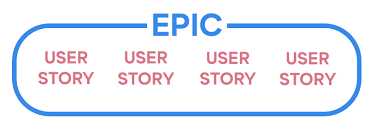

What are epics in an agile context ? Epics group or categorize stories into release features. It plays an important role in the organization and release of features for the product.
For example, an Epic of “Login based on country” can use to group stories as following :
- Develop splash page with login User ID textbox and Login button.
- Login to verify User ID and match against correct password.
- Display after login landing page based on user country.
Above is just a simple example. There are more complicated ones.

Epics also serve as a guide for code branches and releases. A code branch can be based on an Epic (feature) and a release can contain multiple Epics. Taking into example above, there could be another epic “Display landing page” with break down of stories :
- Create and display banner
- Display list of products
- Display vouchers
- Display menu bar
The code branches are advised to follow by epic level so that it can be independent from each other and deployed without dependency on prior completed stories. This will allow the release of next stories if prior completed ones are not ready to be deployed.
It is an important point to take note of because a product that has already gone live and being used by users may have fixes and enhancements on existing functions. The proper naming of the epic and tagging of stories allows a clear understanding of separation between BAU bug fixes or defects and New features (enhancements).
An example of this would be the following :
- BAU bugfixes or defects :
- Bugfix / defect – Login unable to work when clicked on button.
- New features :
- Enhancement – Login to support multi-language

Source : https://www.yodiz.com/blog/what-is-epic-in-agile-methodology-definition-and-template-of-epic/
Disclaimer: What I am sharing is purely from my point of view and does not reflect anyone else’s. What I present in my posts doesn’t necessarily mean tat it is applicable to your work, organization and culture. Would love to hear from you if you have any different opinions or feedback.







